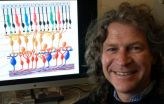(Press-News.org) WHAT:
Using a monkey model of AIDS, scientists have identified a vaccine-generated immune-system response that correlates with protection against infection by the monkey version of HIV, called simian immunodeficiency virus (SIV). The researchers found that neutralizing antibodies generated by immunization were associated with protection against SIV infection. This finding marks an important step toward understanding how an effective HIV vaccine could work, according to scientists who led the study at the National Institute of Allergy and Infectious Diseases (NIAID), part of the National Institutes of Health.
Scientists administered the SIV vaccine to half of the 129 monkeys in this study and a placebo vaccine to the other half. The scientists then gave each monkey up to 12 doses of one of two forms of SIV through rectal injection to simulate sexual exposure to the virus. The vaccine regimen did not protect the monkeys that received one form of SIV, but it reduced the rate of infection by 50 percent in the monkeys that received the other form of the virus.
To learn how the vaccine worked, the study team examined a variety of immune responses and certain genetic factors in the monkeys that the vaccine protected. The scientists found that SIV neutralizing antibodies and the activation of white blood cells known as helper CD4+ T cells correlated with the protective effect. Also, monkeys that expressed two copies of a gene known to help limit SIV replication were better protected by the vaccine than monkeys that did not, demonstrating that genetic factors can contribute to protection.
This study provides evidence that neutralizing antibodies are an important part of the immune response needed to prevent HIV infection. The ability of the vaccine regimen to protect monkeys from SIV infection is comparable to the results seen in the RV144 trial with 16,000 adult volunteers in Thailand; RV144 was the first HIV vaccine study to demonstrate a modest protective effect, reducing the rate of HIV infection by 31 percent. The new research also provides an animal model to better understand the immune basis for vaccine protection against lentiviruses, a subclass of viruses that includes HIV and SIV. This knowledge will help guide strategies for the future development of AIDS vaccines.
The SIV vaccine regimen used in this study was similar to an HIV vaccine regimen currently being tested in humans in the NIAID-funded clinical trial known as HVTN 505. Both vaccine regimens consist of priming with a vaccine made from DNA that encodes immunodeficiency virus proteins, followed by boosting with an inactivated cold virus (adenovirus) that contains immunodeficiency virus proteins.
###
ARTICLE:
L Letvin et al. Immune and genetic correlates of vaccine protection against mucosal infection by SIV in monkeys. Science Translational Medicine DOI: 10.1126/scitranslmed.3002351 (2011).
WHO:
Gary J. Nabel, M.D., Ph.D., director of the NIAID Vaccine Research Center, and John R. Mascola, Ph.D., deputy director of the NIAID Vaccine Research Center, are available for interviews.
CONTACT:
To schedule interviews, please contact Laura Sivitz Leifman, (301) 402-1663, sivitzl@niaid.nih.gov.
NIAID conducts and supports research—at NIH, throughout the United States, and worldwide—to study the causes of infectious and immune-mediated diseases, and to develop better means of preventing, diagnosing and treating these illnesses. News releases, fact sheets and other NIAID-related materials are available on the NIAID Web site at http://www.niaid.nih.gov.
About the National Institutes of Health (NIH): NIH, the nation's medical research agency, includes 27 Institutes and Centers and is a component of the U.S. Department of Health and Human Services. NIH is the primary federal agency conducting and supporting basic, clinical, and translational medical research, and is investigating the causes, treatments, and cures for both common and rare diseases. For more information about NIH and its programs, visit the NIH website.
Antibodies help protect monkeys from HIV-like virus, NIH scientists show
Finding could aid development of HIV vaccine for humans
2011-05-08
ELSE PRESS RELEASES FROM THIS DATE:
Anatomy of an outbreak
2011-05-08
GALVESTON, Texas — What causes a virus to suddenly begin infecting large numbers of people?
Scientists have long known that the process they call "viral emergence" involves a wide variety of factors. Some are changes in the environment, either generated by natural causes or human activity. Others are internal, arising from accidental changes — mutations —in the virus' genetic code.
Studying such mutations in different strains of the chikungunya virus has helped University of Texas Medical Branch researchers solve one of the most puzzling mysteries of chikungunya's ...
Forecast calls for nanoflowers to help return eyesight
2011-05-08
EUGENE, Ore. -- University of Oregon researcher Richard Taylor is on a quest to grow flowers that will help people who've lost their sight, such as those suffering from macular degeneration, to see again.
These flowers are not roses, tulips or columbines. They will be nanoflowers seeded from nano-sized particles of metals that grow, or self assemble, in a natural process -- diffusion limited aggregation. They will be fractals that mimic and communicate efficiently with neurons.
Fractals are "a trademark building block of nature," Taylor says. Fractals are objects with ...
DNA from common stomach bacteria minimizes effects of colitis, U-M study says
2011-05-08
ANN ARBOR, Mich. — DNA from Helicobacter pylori, a common stomach bacteria, minimizes the effects of colitis in mice, according to a new study by University of Michigan Medical School scientists.
The study published in Gut this month was performed by a team of investigators assembled by senior author John Y. Kao, M.D. of the University of Michigan's Division of Gastroenterology and assistant professor in U-M's Department of Internal Medicine. The findings indicate that DNA from H. pylori significantly ameliorates the severity of colitis, say lead authors Jay Luther, M.D. ...
When self-esteem is threatened, people pay with credit cards
2011-05-08
Los Angeles, CA - People shop for high status items when they're feeling low, and they're more likely to make those expensive purchases on credit, according to a study in the current Social Psychological and Personality Science (published by SAGE).
When a person's ego is threatened—by doing poorly on a task, by being told they're not as good as they hoped—people sometimes repair their self-worth by purchasing luxury goods. Because actually parting with cash can be psychologically painful, researchers Niro Sivanathan of the London Business School and Nathan Pettit of Cornell ...
No smoking policies may present challenges to treatment centers
2011-05-08
COLUMBUS, Ohio – When a new tobacco-free policy was instituted at an Ohio women's substance abuse treatment center, both smokers and non-smokers were more likely to leave treatment early in the first few months after the policy change, a new study found.
The results don't mean treatment centers shouldn't try smoking bans, according to the researchers, but they do highlight the challenges involved with implementing a new policy that goes against years of conventional thinking.
Researchers found that the number of patients who completed a program at the women's treatment ...
Study probes sources of Mississippi River phosphorus
2011-05-08
MADISON, WI MAY 5, 2011 – In their eagerness to cut nitrogen and phosphorus pollution in the Mississippi River and Gulf of Mexico, people have often sought simple explanations for the problem: too many large animal operations, for instance, or farmers who apply too much fertilizer, which then flows into waterways.
But according to new modeling research that examined phosphorus loading from all 1768 counties in the Mississippi River Basin (MRB), the true causes aren't nearly so straightforward. Livestock manure is widespread in many MRB counties, for example, but it shows ...
UT Southwestern research reveals how cancer-driving enzyme works
2011-05-08
DALLAS – May 6, 2011 – Cancer researchers at UT Southwestern Medical Center are helping unlock the cellular-level function of the telomerase enzyme, which is linked to the disease's growth.
Their latest findings, published today in Molecular Cell, demonstrate that telomerase repairs chromosomes in one of two ways – depending on whether a cell is dividing normally or if the cell is under stress from enzyme inhibition – and could lead to new or improved cancer-fighting therapies that promote inhibition of this enzyme.
"It's a significant advance in our understanding of ...
Vatican science panel calls attention to the threat of glacial melt
2011-05-08
A panel of some of the world's leading climate and glacier scientists co-chaired by a Scripps Institution of Oceanography, UC San Diego researcher issued a report today commissioned by the Vatican's Pontifical Academy of Sciences citing the moral imperative before society to properly address climate change.
The co-authors of "Fate of Mountain Glaciers in the Anthropocene" list numerous examples of glacial decline around the world and the evidence linking that decline to human-caused changes in climate and air pollution. The threat to the ways of life of people dependent ...
Spikemoss genome offers new paths for biofuels research -- bridges plant development gap
2011-05-08
WALNUT CREEK, Calif.— It's not quite Christmas, but the DNA sequence of a small plant that resembles the seasonal conifers is providing biofuels researchers with information that could influence the development of candidate biofuel feedstock plants and offering botanists long-awaited insights into plant evolution.
"When you burn coal, you're burning Selaginella's ancestors," said Purdue University botanist Jody Banks, who originally proposed that the U.S. Department of Energy (DOE) Joint Genome Institute (JGI) sequence the plant more commonly known as spikemoss as part ...
Weight-loss counseling most prevalent between male physicians and obese men
2011-05-08
San Diego, CA, May 5, 2011 – A study published in the June 2011 issue of the American Journal of Preventive Medicine examined the association between patient–physician gender concordance and weight-related counseling in obese individuals. Investigators from the University of Pennsylvania and Johns Hopkins University found that obese male patients seeing male physicians had higher odds of receiving weight-related counseling than obese women seeing a female physician.
Commenting on the study, Octavia Pickett-Blakely, MD, MHS, Hospital of the University of Pennsylvania, ...
LAST 30 PRESS RELEASES:
Numbers in our sights affect how we perceive space
SIMJ announces global collaborative book project in commemoration of its 75th anniversary
Air pollution exposure and birth weight
Obstructive sleep apnea risk and mental health conditions among older adults
How talking slows eye movements behind the wheel
The Ceramic Society of Japan’s Oxoate Ceramics Research Association launches new international book project
Heart-brain connection: international study reveals the role of the vagus nerve in keeping the heart young
Researchers identify Rb1 as a predictive biomarker for a new therapeutic strategy in some breast cancers
Survey reveals ethical gaps slowing AI adoption in pediatric surgery
Stimulant ADHD medications work differently than thought
AI overestimates how smart people are, according to HSE economists
HSE researchers create genome-wide map of quadruplexes
Scientists boost cell "powerhouses" to burn more calories
Automatic label checking: The missing step in making reliable medical AI
Low daily alcohol intake linked to 50% heightened mouth cancer risk in India
American Meteorological Society announces Rick Spinrad as 2026 President-Elect
Biomass-based carbon capture spotlighted in newly released global climate webinar recording
Illuminating invisible nano pollutants: advanced bioimaging tracks the full journey of emerging nanoscale contaminants in living systems
How does age affect recovery from spinal cord injury?
Novel AI tool offers prognosis for patients with head and neck cancer
Fathers’ microplastic exposure tied to their children’s metabolic problems
Research validates laboratory model for studying high-grade serous ovarian cancer
SIR 2026 delivers transformative breakthroughs in minimally invasive medicine to improve patient care
Stem Cell Reports most downloaded papers of 2025 highlight the breadth and impact of stem cell research
Oxford-led study estimates NHS spends around 3% of its primary and secondary care budget on the health impacts of heat and cold in England
A researcher’s long quest leads to a smart composite breakthrough
Urban wild bees act as “microbial sensors” of city health.
New study finds where you live affects recovery after a hip fracture
Forecasting the impact of fully automated vehicle adoption on US road traffic injuries
Alcohol-related hospitalizations from 2016 to 2022
[Press-News.org] Antibodies help protect monkeys from HIV-like virus, NIH scientists showFinding could aid development of HIV vaccine for humans

